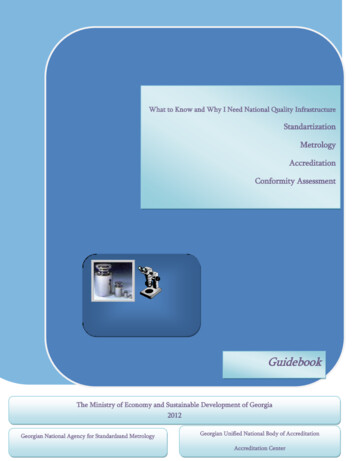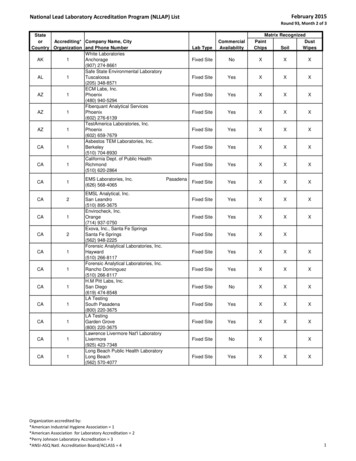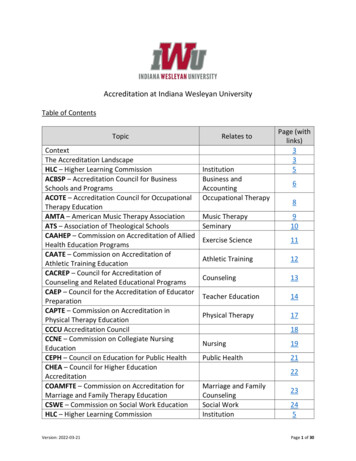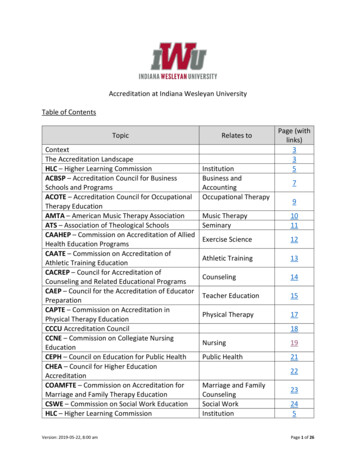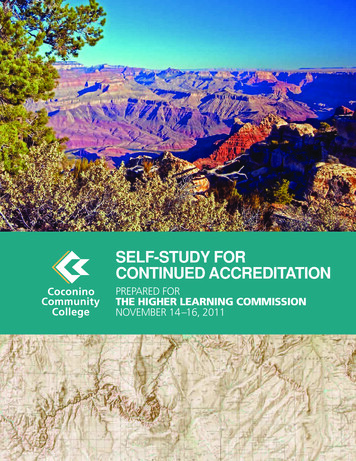
Transcription
SELF-STUDY FORCONTINUED ACCREDITATIONPREPARED FORTHE HIGHER LEARNING COMMISSIONNOVEMBER 14 –16, 2011
TABLE OF CONTENTSCHAPTER 1—College Overview and History .1CHAPTER 2—Organization of the Self-Study Process .11CHAPTER 3—Response to Concernsof the 2002 Visiting Team .21CHAPTER 4—Criterion One: Mission and Integrity .37Core Component 1a .37Core Component 1b .43Core Component 1c .51Core Component 1d .56Core Component 1e .79CHAPTER 5—Criterion Two: Preparing for the Future .95Core Component 2a .95Core Component 2b .104Core Component 2c .128Core Component 2d .137CHAPTER 6—Criterion Three: Student Learningand Effective Teaching .142Core Component 3a .142Core Component 3b .184Core Component 3c .210Core Component 3d .233CHAPTER 7—Criterion Four: Acquisition, Discovery,and Application of Knowledge .250Core Component 4a .250Core Component 4b .269Core Component 4c .276Core Component 4d .288ii
CHAPTER 8—Criterion Five: Engagement and Service .298Core Component 5a .298Core Component 5b .313Core Component 5c .324Core Component 5d .329CHAPTER 9—Ensuring Quality: A Summary of CCC’sSelf-Study for Continued Accreditation .342Cover Photo Courtesy of Joseph Findley Photographywww.findleyphotography.comiii
1COLLEGE OVERVIEWAND HISTORY
COLLEGE OVERVIEW1 ANDHISTORYCOLLEGE OVERVIEW AND HISTORYINTRODUCTIONThe beginnings and vigorous development of Coconino CommunityCollege have been remarkable. At its inception, the “college without walls”held classes in rented spaces throughout its communities. As it continuedits community support alongside growth in student enrollment, the Collegeacquired classrooms in a strip mall on North Fourth Street in Flagstaff, aswell as constructed a campus in Page. Today, CCC’s main campus andadministrative offices are located in an all-in-one classroom facility sited on aforested hill. The College recedes into the natural setting, carefully concealing a 670-car parking area and emphasizing the connection of the interiorspaces to beautiful forest views.A PROFILE OF COCONINO COMMUNITY COLLEGEFlagstaff Lone Tree Campus and District OfficesThis campus was designed by Jones Studio Inc./Rhodes & Associates, Inc.,architects, and Target General, Inc. served as contractor. It was completed inspring 2002. Initial classes were offered in spring 2002, and the dedicationceremony was held in April 2002. The Flagstaff Lone Tree Campus andDistrict Offices feature the following: Construction materials and design intrinsic to the surroundingenvironment Interior design in modern colors 128,017 square feet 33 classrooms 80-station student computer lab Music and art labs Dance studio Registration, advising, and financial aid services Campus Life Center/ Student lounge A “Commons” which hosts various student and community events Food service area More than 670 parking spaces Learning Enhancement Center/Testing Center Information Resources Center/Institutional Archives Average semester headcount: 2,900Page/Lake Powell CampusThe original campus was designed by Kenyon Architectural Group, architects. It was completed in 1997. An expansion was designed by Schneider,Gadbery, Shay & Partners, architects, and was completed in spring 2002. ThePage/Lake Powell Campus features the following:1
COLLEGE OVERVIEW1 ANDHISTORY 20,405 square feet 24-station computer lab/classroom and Microsoft Test Center Learning Enhancement Center with computers Student lounge Distance learning classrooms 12 classrooms 10 full-time employees Unique partnership with Page Public Library Average semester headcount: 480Flagstaff Fourth Street Campus and Technology CenterThe original home of Coconino Community College grew from the shellof a strip mall into a campus. This location houses CCC’s Workforce andBusiness Training Center, which includes the Small Business DevelopmentCenter. The campus also houses CCC’s premier occupational/technicalprograms, including: Administration of Justice, Allied Health, CISCONetworking, Construction Technology, Electronics, Emergency MedicalServices, Nursing, and Fire Science. The Flagstaff Fourth Street Campus andTechnology Center features the following: 60,000 square feet 25 classrooms Approximately 200 computers for student, faculty, and staff use Science lab Nursing lab Distance learning classrooms Learning Assistance Center Average semester headcount: 1,100Williams Course SiteThis site was designed by Schneider, Gadbery, Shay & Partners, architects,and, Lejas Inc. served as contractor. It was completed in December 2001 andthe dedication ceremony was held in March 2002. The Williams site featuresthe following: 4,348 square feet 12-station computer lab/classroom Distance learning classroom Instructional classroom Two offices Average semester headcount: 412
COLLEGE OVERVIEW1 ANDHISTORYGrand Canyon, Tuba City, and Fredonia Course SitesThe College also offers courses at sites at the Grand Canyon (Grand CanyonLearning Center), Tuba City, and Fredonia. Permanent facilities have notbeen built for these course sites. Both sites offer significant opportunitiesto serve Coconino County citizens in remote areas at high schools throughpartnerships with local school districts.HISTORY AT A GLANCECCC’s Critical First 10 years1990 Voters of Coconino County authorize formation of the CoconinoCounty Community College (CCCC) District.1991 Voters authorize the levy of a property tax to raise 2.2 million tofund and operate a community college within Coconino County. CCCC District Governing Board enters into lease agreement for15,600 square feet of classroom and office space in what wereformerly the Gold Bond and Boston stores on North Fourth Street,Flagstaff. Dr. John Glenn becomes the first President of CCCC. CCCC officially begins registration for over 140 classes offered inFlagstaff, Grand Canyon, Page, Sedona, Tuba City, and Williams. CCCC’s Small Business Development Center begins serving Flagstaff, Grand Canyon, Page, Sedona, and Williams.1992 CCCC begins process of seeking affiliation with the Commission onInstitutions of Higher Education of the North Central Association ofColleges and Schools.1993 CCCC holds first commencement and graduates three students. The CCCC Foundation is established.1994 CCCC receives North Central Association (NCA) candidacy status. Dr. V. Phillip Tullar becomes second President of CCCC.3
COLLEGE OVERVIEW1 ANDHISTORY1995 The State Board of Directors for Community Colleges of Arizonaapproves CCCC’s proposed satellite campus and partnership withthe City of Page. The College drops the fourth “C” from its name to become identified as CCC. CCC revises its Mission statement: To promote student success throughcomprehensive learning opportunities for its community. CCC District Governing Board approves the plan for a new Page Campus.1996 CCC receives initial accreditation from the Commission on Institutions of Higher Education of the North Central Association ofColleges and Schools. CCC receives authorization from the Department of Education todisburse Title IV funds. The Arizona Board of Regents unanimously approves plans to makeover 40 acres of Northern Arizona University (NAU) land availableto CCC for a new Flagstaff Campus. College and Page City officials break ground on the Page Campus. CCC Foundation purchases Flagstaff Fourth Street facility.1997 CCC offers its first web-based class—Art History I. The CCC satellite campus in Page is completed. Voters pass a 25 million bond election for the construction of theFlagstaff Lone Tree Campus and District Offices, distance learningtechnology, and completion of the Page Campus. CCC goes online with the creation of its first website.1998 Dr. David A. Williams is appointed interim President of CCC.1999 Dr. Thomas S. Jordan becomes the fourth President of CCC.2000 CCC holds groundbreaking ceremony for the Flagstaff Lone TreeCampus and District Offices. CCC holds groundbreaking ceremony held for Williams Site. CCC holds Open House and Public Forum at Fourth Street facilityfor the unveiling of the proposed plans for the Workforce andBusiness Training Center.4
COLLEGE OVERVIEW1 ANDHISTORYHighlights of the Next 10 years2001 District Governing Board approves new Vision, Mission, CoreValues, and purpose statements. District Governing Board approves official names for CCC facilities:Flagstaff Lone Tree Campus and District Offices, Flagstaff FourthStreet Campus and Technology Center, Page/ Lake Powell Campus,Williams Site, and Grand Canyon Learning Center. Williams Site completed.2002 Flagstaff Lone Tree Campus and District Offices open. 5,000 square foot Navajo Generating Station (NGS) TechnologyCenter completed at the Page Campus, including a computer lab,ITV rooms, offices, boardroom, and classroom. The Center wascompleted in part with a donation of 225,000 from NGS. CCC successfully completed its first Higher Learning Commission(HLC) comprehensive evaluation for continued accreditation with aten year reaffirmation of its accredited status with HLC. CCC begins offering classes through ITV.2003 CCC completes construction on Phase II Remodel of the FourthStreet Campus and Technology Center. CCC admits first class of 21 associate degree RN students.2004 CCC implements action-oriented advertising campaign.2005 CCC adopts its current Mission statement with widespread inputfrom employees, students, and the community: As a learningcentered college, we enrich lives by embracing diversity and transformingthe future through quality education.2006 CCC focuses on two major information initiatives: the Property TaxOverride Election and the 15th Anniversary Celebration. Coconino County residents reject a tax override by a vote of 58percent against and 42 percent in favor of the override question. CCC holds 2006 Mascot Naming Contest – CCC becomes theCoconino Comets.5
COLLEGE OVERVIEW1 ANDHISTORY2007 Commencement ceremony is held at new Pine Mountain Amphitheater at Fort Tuthill County Fairgrounds honoring 189 graduates. Dr. Leah Bornstein becomes fifth President of CCC.2008 CCC strengthens partnership with Northern Arizona University andcreates a collaborative admissions program to increase the numberof baccalaureate degrees in Arizona. CCC establishes Community and Corporate Learning Center toserve Coconino County in contract training, personal enrichment,and the Small Business Development Center. CCC develops and implements an improved strategic planningprocess. CCC creates the Sustainable Financial Plan. The College receivesinquiries about the plan from other colleges across the country andCCC is invited to present the plan at several conferences.2009 CCC establishes President’s Community Advisory Councilsthroughout district. CCC initiates first and second cohorts of CCC2NAU students,creating a seamless transition for community college students touniversity degree paths.2010 CCC dramatically increases collaborative problem solving withNAU: CCC2NAU, library merger, reverse transfer agreement,increased developmental math/English sections at NAU, and sharing of faculty. Paul Newman, first governing board president, and Dr. PattieGibson, a founding faculty member and administrator, present anoral history of CCC from its inception to employees, which resultsin a seven-page document (RRD 1-1 Oral History of CCC). CCC introduces legislation (2010-2011) to be able to bring CCCproperty tax questions directly to county voters. CCC receives a U.S. Department of Education TRiO StudentSupport Services grant for 220,000 per year for five years totaling 1,100,000.2011 CCC receives a distance learning grant of approximately 300,000from the U.S. Department of Agriculture.6
COLLEGE OVERVIEW1 ANDHISTORYToday, Coconino Community College (CCC) serves many diverse communities throughout Coconino County including Flagstaff, Fredonia, GrandCanyon, Page/Lake Powell, Sedona, Tuba City, and Williams. CCC offersuniversity transfer, career/technical programs, high school dual enrollmentand tech prep programs, continuing education, and community interestcourses. Serving approximately 8,296 students annually, the College continues to provide expanding opportunities for traditional and non-traditionalstudents.HISTORYCCC’s Past Points to a Successful FutureIn 1989, a petition drive was launched by a county grassroots committee tocreate the Coconino County Community College District. The voters passedthe referendum authorizing the creation of the College in November 1990.Strong public support was stimulated, in part, by the idea that CoconinoCommunity College would start as a “college without walls” and wouldutilize existing facilities in Flagstaff and other locations. CCC’s early growthcreated challenges to the “college without walls” concept and proved it tobe an inefficient use of resources. The College has since been on a journey todevelop partnerships and seek the resources to build permanent campusesand centers to serve the needs of its residents throughout the county.Established to Provide Affordable HigherEducation to Coconino CountyIn just 20 years, Coconino Community College has grown from a smallcollege enrolling fewer than 970 students in its first year to a highly successful educational institution enrolling approximately 8,300 learners annuallythroughout the District.CCC is challenged to meet the educational needs of its residents, manyof whom are still unable to access higher education due to geographic andeconomic barriers. The College’s service area—long known for its sheerbeauty—includes the Grand Canyon, the San Francisco Peaks, Sedona, LakePowell, the Painted Desert, and Sunset Crater. Coconino County, the secondlargest in the country, spans 18,601 square miles–larger than Connecticut,Delaware, New Jersey and Rhode Island combined. Five sovereign Indiannations govern over one-third of the land, including the Navajo Nation—thecountry’s largest Native American reservation. The County is also diversein population and educational attainment. Although nearly 14 percent ofCoconino County adult residents have less than a high school education(RRD 1-2 U.S. Bureau of the Census), some 32 percent have a bachelor’sdegree or higher. Coconino County has an adult population with the highestproportion of baccalaureate holders of any county in the State of Arizona(RRD 1-3 Percentage of Adult Population (Age 25 ) with Bachelor’s orHigher, ERSI, 2009).7
COLLEGE OVERVIEW1 ANDHISTORYCreated Partnerships to Expand ResourcesTo meet the demand for permanent facilities, CCC formed two majorpartnerships that resulted in two new campuses in Flagstaff and Page. In1995, the College formed a partnership between CCC and the Page PublicLibrary that was used as the model for partnerships with public libraries inorder to serve distance learners and students enrolled at extension sites. Thetwo facilities, designed to complement one another, sit on the CCC Page/LakePowell Campus.The College and Page Public Library shared expenses for library services,library materials, computers, landscaping, and security. Northern ArizonaUniversity also entered the partnership to provide an Interactive TV classroom, bringing upper division courses and degree programs to Page. TheCollege and Page officials broke ground for the Page/Lake Powell Campus inApril 1996. The building was dedicated in October 1997.As enrollment surged at the Flagstaff campus, the College eventuallysecured the remaining square footage in the Fourth Street shopping centerwith the exception of two rental spaces and began searching for land for anew campus. In February 1996, the Arizona Board of Regents approved arecommendation from then NAU President Clara Lovett, to provide over 40acres of land to CCC. In November 1997, Coconino County voters approveda 25 million bond election to build the additional Flagstaff Lone TreeCampus and District Offices, to fund distance-learning technology, and tocomplete the Page Campus. The College broke ground for the Flagstaff LoneTree Campus and District Offices in March 2000. The campus opened forclasses in January 2002.Overcame Public Relations CrisisNarrow passage of the November 1997 bond election resulted in a recalleffort of the CCC District Governing Board members, followed by theresignation of two members. CCC received enormous press surroundingthe issues: the controversial move to the west side of Flagstaff, the continuedutilization of the Fourth Street facility, a reexamination of the building proposal, and a call for more vocational/technical programs. A public information campaign was launched to reinforce the fact that CCC intended to stayin its Fourth Street facility and emphasize occupational/technical programs.The CCC District Governing Board formed a Citizens Advisory Committee toreexamine the design of the Flagstaff Fourth Street Campus. Selected citizensinstrumental in the District Governing Board recall effort were invited toserve. Collaboration between the council, the architects, and the administration resulted in a campus that the community is now embracing.8
COLLEGE OVERVIEW1 ANDHISTORYEnrollment TrendsEnrollment at the College increased rapidly until 1996, but has since leveledoff. The College has begun a strategic enrollment initiative focusing onrecruitment and retention. Enrollment growth is anticipated based on thiseffort and on the new and renovated facilities throughout the District.Number of Credit Students Enrolled Fall 1991 to Fall 2010Summary of Highlights for the First 20 YearsIn the first two decades of service to its community, Coconino CommunityCollege: Graduated over 2,200 students and served many thousands more Earned accreditation from the Higher Learning Commission of theNorth Central Association of Colleges and Schools Served four times as many students as initially projected with thesupport of state and local funding Established educational and student services Established an associate degree in nursing Offered dual enrollment opportunities across the District Offered a GED program in Flagstaff and Page Established two permanent sites in Flagstaff, one in Page, one inWilliams, and additional course sites at the Grand Canyon, TubaCity, and Fredonia Published first Strategic Plan, Challenges of the 21st Century Partnered with Northern Arizona University (NAU) for library,interactive television, classrooms, labs, and other resources Partnered with the City of Page to construct a community collegecampus and public library on land donated by the City Established a CCC/NAU Coordinating Council to continue review of theshared use of resources, facilities, and services between the two institutions Passed a 25 million bond issue to build an additional FlagstaffCampus and provide distance-learning technology Received a five-year, 1.7 million Title III U.S. Department of Education Strengthening Institutions grant Created the CCC2NAU partnership with Northern Arizona University9
COLLEGE OVERVIEW1 ANDHISTORYFuture to Focus on Economic and WorkforceDemographics of Coconino CountyCoconino Community College serves a diverse population of 129,849residents (RRD 1-4 Population estimates, 2009, Arizona Workforce Informer).About half of the total county population resides within 25 miles of Flagstaff;shown in the figure below, while the remaining half reside in rurally isolatedcommunities far removed from the College.FACTS-AT-A-GLANCEEnrollment FY 2009-2010Annual FT Equivalent Student2,361Annual Unduplicated Headcount (credit)6,717Fall 2009 Headcount (credit)4,961By Full-time or Part-timeFall 0%By GenderFall %Total4,961100%By Residency StatusFall e75515%Unknown00%Total4,961100%By Ethnic or Race GroupFall 2009Non-resident Alien351%Black, non-Hispanic842%Am Indian/Alaskan Native1,21124%Asian or Pacific Islander741%Hispanic48410%White, 961100%Instructional StaffFall 2009Full-time Instructors4518%Part-time Instructors19982%Total244100%10
2ORGANIZATION OF THESELF-STUDY PROCESS
ORGANIZATION OF THE SELF-STUDY PROCESSCoconino Community College (CCC) launched its self-study for continuedaccreditation in October, 2008 with the presidential appointment of a chairand co-chair to provide leadership and direction to the process. The president appointed a second co-chair later during the process. This leadershipteam included the Executive Dean of the Page/Lake Powell Campus, Directorof Institutional Research and Assessment, and a mathematics faculty member.The team met regularly throughout the process and provided the oversightneeded to complete a successful self-study.ORGANIZATION OF THE2 SELF-STUDYPROCESSDuring the College’s 2010 strategic planning retreat, the Strategic PlanningCommittee decided to append one more year to the current strategic planning cycle so that the findings of the current self-study and recommendationsof the HLC visiting team could be incorporated into the College’s nextstrategic plan. Hence, this self-study set the stage for the next iteration of theCollege’s strategic plan.Professional development activities introducing employees to the self-studyprocess began at all campuses in October 2008 and continued through spring2009. The team gave PowerPoint presentations to each department throughout the College and provided information to faculty, staff, and administrationon the following accreditation topics: purposes and benefits, self-study andpeer review, criteria and core components, and the self-study process (RRD2-1 Professional Development PowerPoint Presentations). In addition, several employees attended the 2009-2011 Higher Learning Commission (HLC)annual conferences in Chicago. Attendees participated in sessions relatingdirectly to the self-study process as well as the regular sessions offered during the conference. Conference attendees discussed what they learned at theHLC annual conferences with the Steering Committee. In 2011 a CCC facultymember co-presented a session on portfolio assessment in the fine arts atthe HLC annual conference. Professional development activities continuedthroughout the self-study for faculty, staff, students, District GoverningBoard members, and participants on various College advisory boards.FORMATION OF SELF-STUDY STRUCTUREThe co-chairs developed a self-study plan for continued accreditation insummer, 2009 which set forth the purposes of CCC’s self-study process: To encourage continuous institutional improvement To support and enhance institutional effectiveness and planningefforts To foster open communications throughout the College To support an institutional research and assessment capacity thatassists in the self-study as well as institutional planning activities To achieve continued accreditation11
The Steering Committee approved the plan and adopted a self-study designthat focused on the criteria for accreditation and each of the twenty-one corecomponents. The plan established the structure for the self-study process,the organization of the self-study report, and included timelines for completion of each aspect of the process up through the November 2011 visit (RRD2-2 Self-Study Plan for Continued Accreditation).ORGANIZATION OF THE SELF-STUDYNine teams formed the primary structure of CCC’s self-study process:Steering CommitteeFive Criterion CommitteesEditing CommitteeTechnology Support CommitteeVisit and Hospitality CommitteeORGANIZATION OF THE2 SELF-STUDYPROCESS Departments throughout the College invited volunteers to serve on thevarious committees, and the College President made formal appointments.Representation on the twenty-one member Steering Committee includedfaculty, staff, administration, students, alumni, and community members.The self-study chair and co-chairs planned the agenda for monthly meetingsof the Steering Committee, which included representatives from the Criterion,Technology, Editing, and Visit and Hospitality Committees. Throughout thisdocument and in discussions across the College the terms “committee” and“team” are used interchangeably when referring to the self-study process.Membership on the self-study committees included:SELF-STUDY STEERING COMMITTEELloyd H. Hammonds, ChairExecutive Dean for the Page/Lake Powell CampusStephen Chambers, Co-ChairDirector of Institutional Research and AssessmentJennifer Jameson, Co-ChairFull-Time Faculty, MathematicsMonica BakerDean of Career and Technical EducationShane BrownCCC AlumnusCharlie BynarStudentJohn CardaniExecutive Director of Community and Corporate LearningKathleen CorakVice President of Academic AffairsMark EastonExecutive Director of FacilitiesRuth FosterFull-Time Faculty, Developmental English and ReadingPattie GibsonNorthern Arizona University, Associate Professor, EducationalLeadershipVeronica HipolitoDirector of Student Support ServicesKirk KellyFull-Time Faculty, Computer Information SystemsIngrid LeeDean of Arts & Sciences12
Ana NovakScience Lab Coordinator and Part-Time Faculty, ScienceAdrian Patel-DelaloyeStudentAlan PetersenFull-Time Faculty, Fine ArtsJoe TrainoChief Technology OfficerJami Van EssVice President for Business and Administrative ServicesBob VoytekDirector of Financial Aid and Veteran ServicesJoan WhiteExecutive Assistant to the PresidentCRITERION ONE COMMITTEEVice President of Academic AffairsMark EastonExecutive Director of FacilitiesKathy NesbitTech Prep/Perkins/High School Transitions CoordinatorDave RudakewichFull-Time Faculty, History and Political ScienceBob VoytekDirector of Financial Aid and Veteran ServicesNina WebbFull-Time Faculty, NursingORGANIZATION OF THE2 SELF-STUDYPROCESSKathleen Corak (Chair)CRITERION TWO COMMITTEEJami Van Ess (Chair)Vice President for Business and Administrative ServicesTom Lehman (Co-Chair)Full-Time Faculty, Anatomy and PhysiologyTheresa AlvaradoDirector of Human ResourcesBryan BatesFull-Time Faculty, BiologyRose CalvinGrant AccountantCindy CookControllerEd KnechtFull-Time Faculty, BusinessPat NelsonBudget AnalystBobby SedilloDirector of Purchasing and Auxiliary ServicesKim SonierFull-Time Faculty, MathematicsGeorge WestFinancial Aid, Departmental IT AnalystCRITERION THREE COMMITTEEStephen Chambers (Chair)Director of Institutional Research and AssessmentCharlie Brown (Co-Chair)Full-Time Faculty, SpanishLinda BarkerFull-Time Faculty, SociologyDoris BeranFull-Time Faculty, Allied HealthChris BlackLearning Assistance CoordinatorTroy CayouFull-Time Faculty, ChemistryGreg ClarkCCC AlumnusPatricia HaeuserNorthern Arizona University, Vice President for InstitutionalEffectiveness13
Kimberly KhatibiDisability Resources CoordinatorJanis McMillanFull-Time Faculty, NursingHolly OakleafTesting CoordinatorAlan PetersenFull-Time Faculty, Fine ArtsSarah RencherFull-Time Faculty, Computer Information SystemsMargot SaltonstallNorthern Arizona University, Assessment CoordinatorJB WarnerFull-Time Faculty, Biology and ChemistryCRITERION FOUR COMMITTEEDean of Arts & SciencesBarb EickmeyerFull-Time Faculty and Chair, LanguagesJohn HennebergCareer Services CoordinatorAna NovakScience Lab Coordinator and Part-Time Faculty, ScienceKarla PhilipsCurriculum & Articulation Services CoordinatorRobin RickliDevelopment Coordinator, Human ResourcesJim RhodesFull-Time Faculty, Psychology and SociologyORGANIZATION OF THE2 SELF-STUDYPROCESSIngrid Lee (Chair)CRITERION FIVE COMMITTEEJohn Cardani (Chair)Executive Director of Community and Corporate LearningMonica Baker (Co-Chair)Dean of Career and Technical EducationDave BowmanFull-Time Faculty and Chair, Computer Information SystemsRobert ErbFoundation DirectorMirjana GlisovicFull-Time Faculty, MathematicsVeronica HipolitoDirector of Student Support ServicesMichele MetcalfFull-Time Faculty, Psychology and Sociology, Chair Social &Behavioral SciencesNik ZatezaloFull-Time Faculty, Business, Economics and AccountingAnnette ZinkyDirector, Small Business Development CenterEDITING COMMITTEERuth Foster (Chair)Full-Time Faculty, Developmental English and ReadingJerry BakerFull-Time Faculty, EnglishSandra DihlmannFull-Time Faculty, EnglishAlex FrawleyCommunity and Corporate LearningJeremy MartinFull-Time Faculty, Developmental English and Writing14
TECHNOLOGY SUPPORT COMMITTEEJoe Traino (Chair)Chief Technology OfficerKirk KellyFull-Time Faculty, Computer Information SystemsJohn KofonowSenior Graphic Design SpecialistJared LoganManager, Information Technology User ServicesHolly OakleafTesting CoordinatorSusan StokesAccounting Information Technology AnalystVISIT/HOSPITALITY COMMITTEEExecutive Assistant to the PresidentVal
Flagstaff, Grand Canyon, Page, Sedona, Tuba City, and Williams. CCCC's Small Business Development Center begins serving Flag-staff, Grand Canyon, Page, Sedona, and Williams. 1992 CCCC begins process of seeking affiliation with the Commission on Institutions of Higher Education of the North Central Association of. Colleges and Schools. 1993







